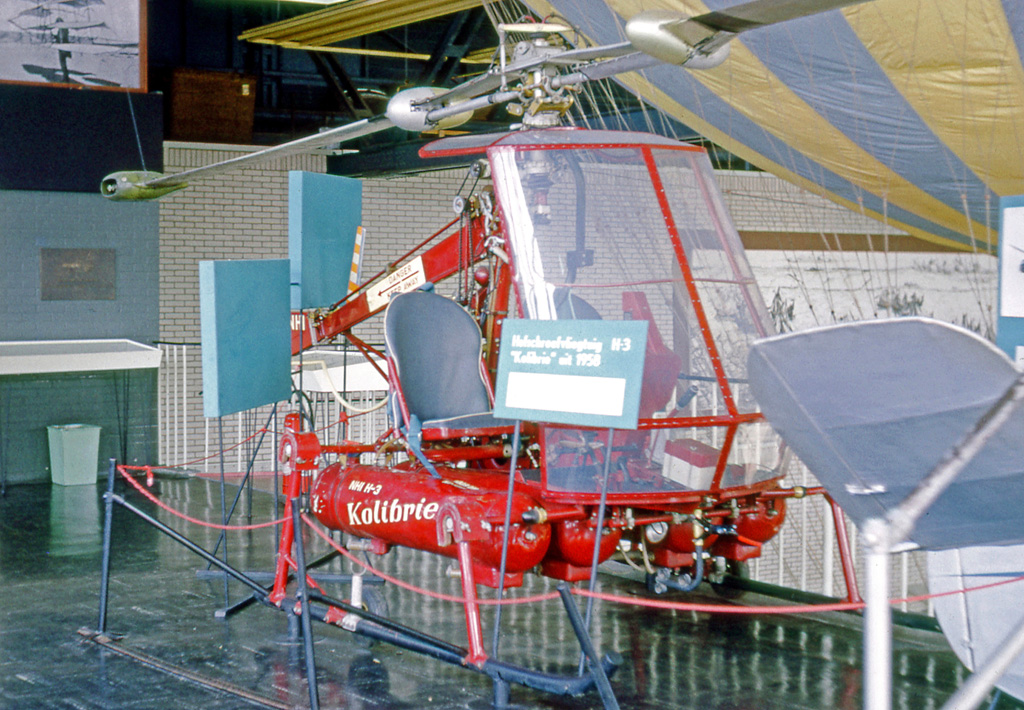NHI H-3 Kolibrie on:
[Wikipedia]
[Google]
[Amazon]
The NHI H-3 ''Kolibrie'' (Dutch for "Hummingbird") was a small helicopter developed in the Netherlands in the 1950s by Nederlandse Helikopter Industrie. It first flew in May 1956.
 Although the H-3 was considered to be a technical success, it was never successful commercially. Despite its low acquisition price, the project became a failure. Several factors contributed to this. First, the Hiller OH-23 Raven was provided to the
Although the H-3 was considered to be a technical success, it was never successful commercially. Despite its low acquisition price, the project became a failure. Several factors contributed to this. First, the Hiller OH-23 Raven was provided to the
Design
The H-3 was a two seat general purpose helicopter. It had a duraluminium tube superstructure, an open cockpit and an undergear of metal skids. The design is typical of ultra-light helicopters of the period, being powered by tip-jets — two ramjets, one at the tip of each rotor blade. The small tail rotor, powered by the motion of the main rotor, was necessary only for yaw control since the tip-jets eliminated the need for an anti-torque force. The ramjets could burn multiple types of fuel, giving the helicopter a certain versatility. The Kromhout-designed-and-built ramjets generated thrust and made a complex gear box unnecessary. Later, Aviolanda-built ramjets generated thrust. In order to start the ramjets, a small auxiliary power unit spun the main rotor to 70 rpm, at which point the ramjets could be ignited. Variants with skis, flotation devices, and medical evacuation stretchers were developed and tested, but these versions were never produced. After developing a crop duster version, the H-3 was mainly marketed for that purpose.Production
The H-3 was assembled at Aviolanda. Subassembly took place at Aviolanda which built the fuselage and at Kromhout which built the engines.Fokker
Fokker was a Dutch aircraft manufacturer named after its founder, Anthony Fokker. The company operated under several different names. It was founded in 1912 in Berlin, Germany, and became famous for its fighter aircraft in World War I. In 1919 ...
, a subcontractor to NHI, built the rotorblades. Final assembly took place at the newly opened Rotterdam Airport
Rotterdam The Hague Airport (formerly ''Rotterdam Airport'', ''Vliegveld Zestienhoven'' in Dutch), is a minor international airport serving Rotterdam, the Netherlands' second largest city, and The Hague, its administrative and royal capita ...
.
The initial production run counted ten helicopters of which the first three were used for development, testing and airworthiness tests. The second production run of ten helicopters was to be undertaken by Aviolanda after Kromhout left the joint venture. This second production run was to be equipped with an uprated ramjet. It is unsure whether the improved ramjet was ever produced.
Commercial failure
 Although the H-3 was considered to be a technical success, it was never successful commercially. Despite its low acquisition price, the project became a failure. Several factors contributed to this. First, the Hiller OH-23 Raven was provided to the
Although the H-3 was considered to be a technical success, it was never successful commercially. Despite its low acquisition price, the project became a failure. Several factors contributed to this. First, the Hiller OH-23 Raven was provided to the Royal Netherlands Air Force
, colours =
, colours_label =
, march = ''Parade March of the Royal Netherlands Air Force''
, mascot =
, anniversaries =
, equipment ...
by the United States free of charge, under the Mutual Defense Assistance Pact
The Mutual Defense Assistance Act was a United States Act of Congress signed by President Harry S. Truman on 6 October 1949. For US Foreign policy, it was the first U.S. military foreign aid legislation of the Cold War era, and initially to Euro ...
(MDAP). Second, NHI's two most important designers, Jan M. Drees and Gerard F. Verhage, left the company, which never recovered. Third, the ramjets not only required a great deal of development to make them viable for production, but potential buyers regarded them as unsafe. Fourth, the extraordinary fuel consumption of the ramjets made the helicopter uneconomical to operate; flight time and range were quite limited, making the helicopter unattractive for commercial or military use. Finally, the ramjets were incredibly loud: during testing, complaints were filed by people living over 5 kilometers away from the test site.
Production list
Overall, nine H-3’s were built between 1958 and 1959 by NHI at Rotterdam Airport when Kromhout was still a parent company. After Kromhout left, Aviolanda built another two H-3’s at their Papendrecht plant. The few production models were mainly exported to Israel, Germany, the UK and Netherlands New Guinea. A few models stayed in the Netherlands.Specifications (H-3 Kolibrie)
See also
* Fairey Rotodyne - a gyrodyne (jet tipped rotor driven at take off and landing only) *Rotary Rocket
Rotary Rocket Company was an aerospace company in the late 1990s. Its founders were among the first to recognize that the end of the Cold War represented a significant shift away from the militarization of space, to a new civilian-led, commercia ...
- with rocket tipped rotor blades
* Hiller YH-32 Hornet - another helicopter with ramjet powered rotorblades
References
{{Reflist 1950s Dutch civil utility aircraft 1950s Dutch helicopters Tipjet-powered helicopters Aircraft first flown in 1956